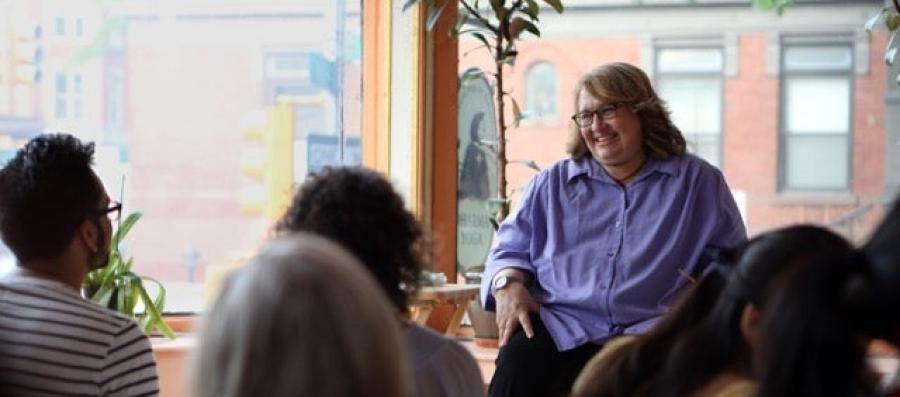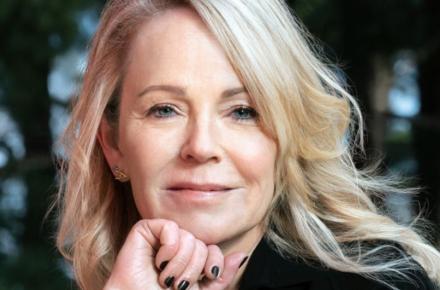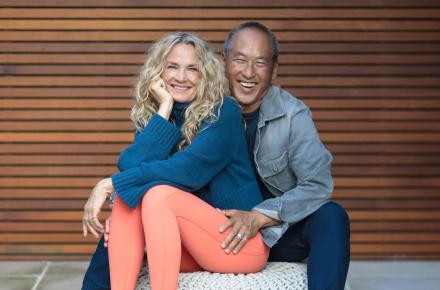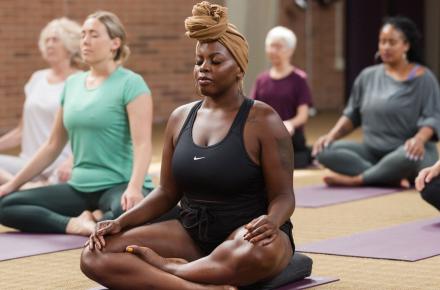Sharon Salzberg on How Loving-Kindness Changed Her Story


StoryFlow is a series featuring original conversations with Kripalu presenter Lisa Weinert and visionary doctors, writers, yogis, and spiritual leaders about the role of storytelling in their healing and caregiving processes. In this edition, trailblazing meditation teacher and prolific writer Sharon Salzberg talks about how meditation and storytelling taught her how to shift the narrative she grew up in, find inner balance, and share this healing message with others.
Born and raised in Queens, New York, Sharon had a tumultuous and painful childhood, which she writes about her in memoir, Faith; she says that reading and writing saved her life. She first learned about the Buddha’s story at the State University of New York at Buffalo in the 1960s, and ultimately made the courageous leap to travel to India and Burma to study meditation and the technique of loving-kindness firsthand. A visionary in the mindfulness space, she is one of the only women who has been on the frontlines since the beginning of this movement in the West.
At heart, Sharon is a writer, and her teachings are rooted in empowering others to unlock their own stories and uncover their own loving-kindness. We spoke about her journey and her process of uncovering her own story.
Lisa What has the role of storytelling been in your healing process?
Sharon It was a long time before I realized that I had a very, very limited narrative thread that was thematic of my life. What I expected of people, what I expected of myself, what I thought was going to happen, what I thought my life was about … I was very frightened.
What was the role of reading and writing in your life as a child?
I was totally a reader. I was saved by the New York Public Library. All I did was read. If you asked me what I wanted to be when I grew up, I would say a writer.
Your memoir, Faith, is the most vulnerable of all of your 10 published titles, because it details your difficult childhood. What was the story you had been telling yourself up until writing that book?
The predominant story at that point in time in my life was of being excluded. I was different. I didn’t have a normal-looking family. I didn’t know that no one’s family was really normal. I thought there was an “Ozzy and Harriet” normality somewhere and that other people had it and I didn’t. So, I was always on the outskirts, on the outside, being different. Then I went to college and took this East Asian philosophy course. I heard the Buddha’s story as a story, really as a counter-narrative that said, maybe you will suffer a lot but you can do something about that. Or, everybody suffers, you’re not weird, you don’t need to feel isolated and excluded, this is a part of life, suffering is a part of the story of life, wherever we are. So that was really the beginning.
Do you remember how you experienced this new story for the first time?
I was just sitting in class, listening. I thought, I want to go to India and study meditation. I looked around and I didn’t see [meditation] anywhere at that time, and so I went. From then on, it was really a cultural shift about everything. I was in another culture and it was a culture where there are fewer secrets.
What do you mean by that?
It felt like everything in life was happening out on the streets, it wasn’t happening behind closed doors. People were being born on the streets, people were dying on the streets. If someone was crazy and ranting, they were ranting on the streets. There was just a certain inclusiveness about life.
How did that perspective disrupt your narrative?
It was all in meditation. I didn’t write for a very long time on this trip, except we all had notebooks because this was before computers and cell phones. You had to write down everything. It was all so new, there weren’t any books on meditation or anything like that.
When did your writing journey really begin?
I went to Burma in 1985 and was the first person in my community to do a three-month intensive in loving-kindness practice, which then became a four-year dedication to just doing loving-kindness. It was pioneering and controversial. People would say things like, “It’s not a wisdom practice, people will only see emptiness that way,” or, “It’s just a feel-good practice.” It’s too "girly" for a lot of people, but I just felt that it was essential for me to come to a better place of balance.
Something that’s interesting about loving-kindness practice is the emphasis on language. Can you talk a little bit about how words work to transform in this tradition?
One way loving-kindness practice is done is by resting your attention on the silent repetition of certain phrases: May I be peaceful, may I be happy. The words serve as the conduit and guide for paying attention differently. The words are imperfect, and words are difficult, too. People can struggle endlessly, like, What do you mean by “happy”? But the words can replace our automatic judgments.
Did you have that experience yourself?
Well, I was in Burma and it was much less flexible. Depending on who was translating that day, you got a set of phrases: "May I be free from danger (inner and outer danger)." The feeling tone is a blessing, like giving someone a birthday card. "May you have a great year." So, we say, "May I be free from danger, may I be free of mental suffering, may I be free from physical suffering, may I have ease of well-being. May things not be such a struggle—family, relationships, livelihood."
Did you have any trouble with these phrases?
May I live with ease—I didn’t like that last phrase so much. I thought it was kind of trivial, I thought it was so stupid. I tried it out [and] one day, the whole thing shifted. I thought to myself, our lives are so complicated, we have so many choices, and so many decisions to make and so many moral dilemmas and I thought May I live with ease—I love that phrase! It just took time. And then, when I came back and started teaching, I just kept suggesting the phrases I had used because it had been such a transformational time for me. It worked fine on the East Coast, and then I got to California and they said, “I don’t like to use a word like danger, I don’t want to repeat suffering, suffering, suffering.” So, we tend these days to suggest things like, "May I be safe." People find their own phrases, too. It’s fine.
In your experience, how does telling yourself these phrases take the place of the initial judgment? How does that work?
It works on a couple of different levels. One is in our worldview, because you don’t stop with yourself. You offer it to those close to you, those you don’t know that well, those you have difficulty with, and ultimately to all beings. It’s a reaffirmation of how connected our lives are. Over time, you have enough experience that you really get that embodied sense of what that’s like.
Returning to your writing, why did you decide to write a memoir?
My first book, Lovingkindness, was expressive of what my life was about, and that technique. Someone had asked me, “What do you do when your first book expresses your whole life’s work?” ”I guess I go deeper,” I said. He said, “What’s deeper?” And I just said, “Faith.” [But] it’s a particular meaning of faith, it’s showing up and keeping going.
My editor said, “So, what’s the opposite of faith?” and I said “despair.” That was the word that came out of my mouth. And she said, “Tell me your despair story.” And I said, “I don’t think I want to. Let’s leave that out!” I thought I didn’t want my lowest moment in there, when I lost all faith in this book. That’s why it was so hard to write.
How did it feel once you got it out?
It felt tremendous, actually. There’s a line in there that’s a real transition point for me. The basis of that despair story is that my mother died when I was nine, and I thought that was resolved, and it was resolved in many ways because I had a very wonderful life. But there was clearly some stuff that was unresolved and it came back when I was doing an intensive meditation, and it was really painful. There was some moment in the writing when I realized that really this was my mother’s story. She was a 37-year-old woman who was dying and leaving her child. She was a single mother. In that moment I realized that was the resolution.
What was your writing practice when writing Faith?
I had a lot of conversations. One friend of mine said, “Stop thinking of yourself as the person who has to write this book and start thinking of yourself as the first person who gets to read this book.” I thought this was totally right. I tend to write about the things we’re talking about, like love and faith, but an unfortunate tendency I have in writing is getting too idealistic and high-falutin’. People often think you’re writing a book like this because you’re an expert and you’re sharing your expertise. More often than that, you’re writing a book like this because you’re trying to figure out the topic. And the writing is part of the figuring out.
Did you have a disciplined practice around your writing?
Meditation is key to my writing process. I don’t successfully sit down to meditate thinking I’m going to resolve a dilemma. I just sit and a lot of spaciousness is created and very often some kind of intuition is created.
I am a night owl. I often end the day … and just go write. I sometimes write in the morning even though I’m groggy, because the censor hasn’t woken up yet, and there are things that come to me that are pretty good.
Something about your story that’s so inspiring and moving to me is its simplicity. It’s the story of a small girl who is abandoned and alone and traveling to this strange city, and then an even stranger place, and comes back to tell her story to heal others, because in doing so she is healed—it’s such a simple and radical way of healing. You’re basically doing loving-kindness meditation over and over and over again.
The great gift is that it comes back to me.
Find out about upcoming programs with Sharon Salzberg and Lisa Weinert at Kripalu.
© Kripalu Center for Yoga & Health. All rights reserved. To request permission to reprint, please email editor@kripalu.org.
















































